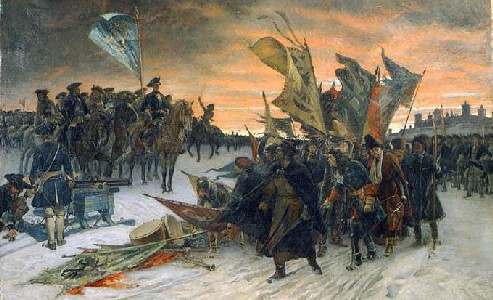|


The first major battle in the
Great Northern War was fought outside the Swedish fortress of Narva
20 November (Swedish calendar) or 19 November (Julian calendar, used by the
Russians) or 30 November 1700 (Gregorian calendar). This fortress had been
under siege by a Russian army (between 35,000 and 38,000 men strong) since
September and it was not able to hold out much longer when the Swedish king
Charles XII arrived with his army. The Swedes were however only 10,537 men strong
and Charles XII took a great risk when he attacked a three times larger army
entrenched behind field fortifications (a contravallation). But the fortress of Narva was too
important and the Swedes were forced to attempt to end the siege. This
enterprise was aided by the fact that the Russian contravallation was too
long for the Russian army to properly defend it. Faced against a very thin
Russian battle line the Swedes chose to concentrate their attack on two
points by attacking in columns. They were also favoured by heavy snow fall
which blew against the Russians and obstructed their view. This attack split the
Russian army into three parts which were then fought separately by the
Swedes. And instead of being a protection for the Russian army the
contravallation, screened by Swedish cavalry, became a barrier which
prevented the Russians from escaping the battle field. Thus resulting in the
battle becoming the greatest military victory in Swedish history.
On the Russian side between 8,000 and 9,000 men
were killed or injured and most of the injured would not survive the journey
back home to Russia. The number of Russians surrendering to the Swedes was
so large that Charles XII only took the officers as prisoners and allowed
the privates safe passage home. The battle had however been hard fought and
the Swedes had also suffered heavy casualties (see below). Even though the
Russian army had been inflicted a catastrophic defeat the Swedish army was
in such poor condition that a continuation of the campaign into Russia was
not considered. The Russians could therefore spend the entire winter to
rebuild their army and recover just in time for next year's campaign season.
So the battle of Narva was despite of the crushing Swedish victory only the
beginning of a 22 year long war which would end in anything but a favourable
way for the Swedish side.
The participating soldiers were
however blissfully unaware of how long the war would last and the following
pages can give an impression of how they looked:
The losses of the 10,537 men strong Swedish army in the battle were as
follows:
| |
Killed |
Injured |
|
Officers |
NCOs
and privates |
Officers |
NCOs
and privates |
Drabant Corps
Livgardet
Liv-dragoons
Dal-regiment
Hälsinge
Västmanland
Närke-Värmland
Other units |
12
7
-
3
2
1
3
3 |
-
120
45
55
24
92
100
200 |
26
14
9
7
2
4
3
1 |
-
170
93
121
100
197
200
300 |
| Sum |
31 |
636 |
66 |
1 181 |
The image above is a painting from 1905 by Gustaf Cederström (1845-1933)
and it shows how the Russians surrendered their colours to Charles XII after
the Swedish victory at Narva. As usual with this type of paintings not many
details are historically correct. |

